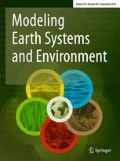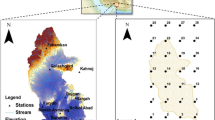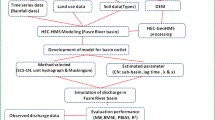Abstract
Use of NWP model rainfall forecast is useful for hydrological modelling for river basins for flood and water management. In this study, the SWAT model is applied to the Narmada river basin to estimate the surface runoff. The capability of the model is tested for the south west monsoon season (June–September) of 2016 and validated against the NCUM global NWP model forecast data up to Day-5. Two heavy rainfall events are used for verification of the global model forecast with the observed data. The two verification events occurring during 1 July to 15 July (mean of 15 days) and 30 Aug to 11 Sept (mean of 12 days) are considered. Using Arc GIS sub watershed boundaries, the drainage network, slope, land use map and soil map are generated for the whole Narmada river basin. The surface runoff is computed by forcing with observed rainfall data as well as the NCUM model rainfall forecasts data as input to the SWAT model. Model simulations are compared at five stations of Narmada namely—Balkheri, Sandia, Handia, Hoshangabad and Garudeshwar. Initially, the NCUM model rainfall forecast is compared with the actual observation to evaluate the model performances in terms of bias estimation. Then the surface runoff is computed using the observed rainfall data and NCUM forecast data up to Day-5 and made a comparison to evaluate the SWAT model performances. It is shown that the estimated surface runoff during the two active phases is simulated well with some overestimation during the season. The skill of hydrological simulations is examined during different length of forecasts. It is seen that the SWAT model output performance is related to the NWP rainfall forecast skills. NCUM global NWP model is overestimating rainfall amount (wet bias) by 50–70 mm/day over the basin during the two active phases. Further, in all the days’ forecasts, the model is showing wet bias over the upper part of the Narmada river basin and a dry bias over the lower part of the basin. The dry bias is seen to be around 5–35 mm/day.








Similar content being viewed by others
References
Arnold JG, Srinivasan R, Muttiah RS, Williams JR (1998) Large area hydrologic modeling and assessment part I: model development. Am Water Resour Assoc 34(1):73–89
Arora VK (2002) The use of the aridity index to assess climate change effect on annual runoff. J Hydrol 265:164–177
Bronstert A, Niehoff D, Bürger G (2002) Effects of climate and land-use change on storm runoff generation, present knowledge and modelling capabilities. Hydrol Process 16:509–529
Chandrashekar VD, Shetty A, Singh BB, Sharma S (2017)) Spatio-temporal precipitation variability over Western Ghats and coastal region of Karnataka, envisaged using high resolution observed gridded data. Model Earth Syst Environ 3:1611. https://doi.org/10.1007/s40808-017-0395-8
Chung WH, Wang IT, Wang RY (2010) Theory-based SCS-CN method and its applications. J Hydrol Eng 15(12):1045–1058. https://doi.org/10.1061/(ASCE)HE.1943-5584.0000281
Fadil Rhinane H, Kaoukaya A, Kharchaf Y, Bachir OA (2011) Hydrologic modeling of the Bouregreg Watershed (Morocco) using GIS and SWAT model. J Geogr Inf Syst 3:279–289
Gassman PW, Reyes MR, Green CH, Arnold JG (2007) The soil and water assessment tool: historical development, applications, and future research directions. Am Soc Agric Biol Eng 50(4):1211–1250
Geetha K, Mishra SK, Eldho TI, Rastogi AK, Pandey RP (2007) Modification to SCS-CN method for long-term hydrologic simulation. J Irrig Drain Eng 133(5):475–489 https://doi.org/10.1061/(ASCE)0733-9437(2007)133:5(475)
Manaswi CM, Thawait AK (2014) Application of soil and water assessment tool for runoff modeling of Karam river basin in Madhya Pradesh. Int J Sci Eng Technol 3(5):529–532 (ISSN:2277-1581)
Goswami SB, Kar SC (2017) Simulation of water cycle components in the Narmada River basin by forcing SWAT model with CFSR data. Meteorol Hydrol Water Manag. https://doi.org/10.26491/mhwm/76250
Mitra KA, Momin IM, Rajagopal EN, Basu S, Rajeevan MN, Krishnamurty TN (2013) Gridded daily Indian monsoon rainfall for 14 seasons: merged TRMM and IMD gauge analyzed values. J Earth Syst Sci 122:1173–1182
Mohamad I, Markus M (2009) Impacts of urbanization and climate variability on floods in northeastern Illinois. J Hydrol Eng 14(6):606–616
Nayak T, Verma MK, Hema B (2012) SCS curve number method in Narmada basin. Int J Geomat Geosci 3(1):219–228 (ISSN 0976-4380)
Omani N, Tajrishy M, Abrishamchi A (2007) Modeling of a River Basin Using SWAT Model and SUFI-2. In: 4th international conference of SWAT Model UNESCO-IHE Delft, Netherlands July 4–6
Rajagopal EN, Iyengar GR, George JP, Das GM, Mohandas S, Siddharth R et al. (2012) Implementation of Unified Model based analysis-forecast system at NCMRWF; Tech. Rep. NMRF/TR/2/2012, National Centre for Medium Range Weather Forecasting Ministry of Earth Sciences, Noida
Rajat KS, Goswami SB, Sarita T, Sarat CK (2015) Evaluation of daily rainfall-runoff simulations in Narmada river basin. Int J Earth Sci Eng 08(03):1123–1132 (ISSN 0974-5904)
Sarkar A, Dutta D, Chakraborty P, Das S (2017) Numerical diagnosis of situations causing heavy rainfall over the Western Himalayas, model. Earth Syst Environ 3:515. https://doi.org/10.1007/s40808-017-0310-3
Sharad KJ, Vijay K (2012) Trend analysis of rainfall and temperature data for India. Curr Sci 102(1):37–49
Sharma K, Ashrit R, Ebert E, Mitra AK, Bhatla R, Iyengar G, Rajagopal EN (2018) Assessment of met office unified model (UM) quantitative precipitation forecasts during the Indian summer monsoon: contiguous rain area (CRA) approach. J Earth Syst Sci (In Press)
Shrivastava S, Bal PK, Ashrit R, Sharma K, Lodh A, Mitra AK (2017) Performance of NCUM global weather modeling system in predicting the extreme rainfall events over the central India during the Indian summer monsoon 2016. Model Earth Syst Environ 3:1409–1419. https://doi.org/10.1007/s40808-017-0387-8
USDA (1972) Soil Conservation Service. National Engineering Handbook, hydrology Sect. 4, Chaps. 4–10
Acknowledgements
The authors are thankful to Head, NCMRWF for his encouragement for this work.
Author information
Authors and Affiliations
Corresponding author
Rights and permissions
About this article
Cite this article
Goswami, S.B., Bal, P.K. & Mitra, A.K. Use of rainfall forecast from a high-resolution global NWP model in a hydrological stream flow model over Narmada river basin during monsoon. Model. Earth Syst. Environ. 4, 1029–1040 (2018). https://doi.org/10.1007/s40808-018-0436-y
Received:
Accepted:
Published:
Issue Date:
DOI: https://doi.org/10.1007/s40808-018-0436-y




